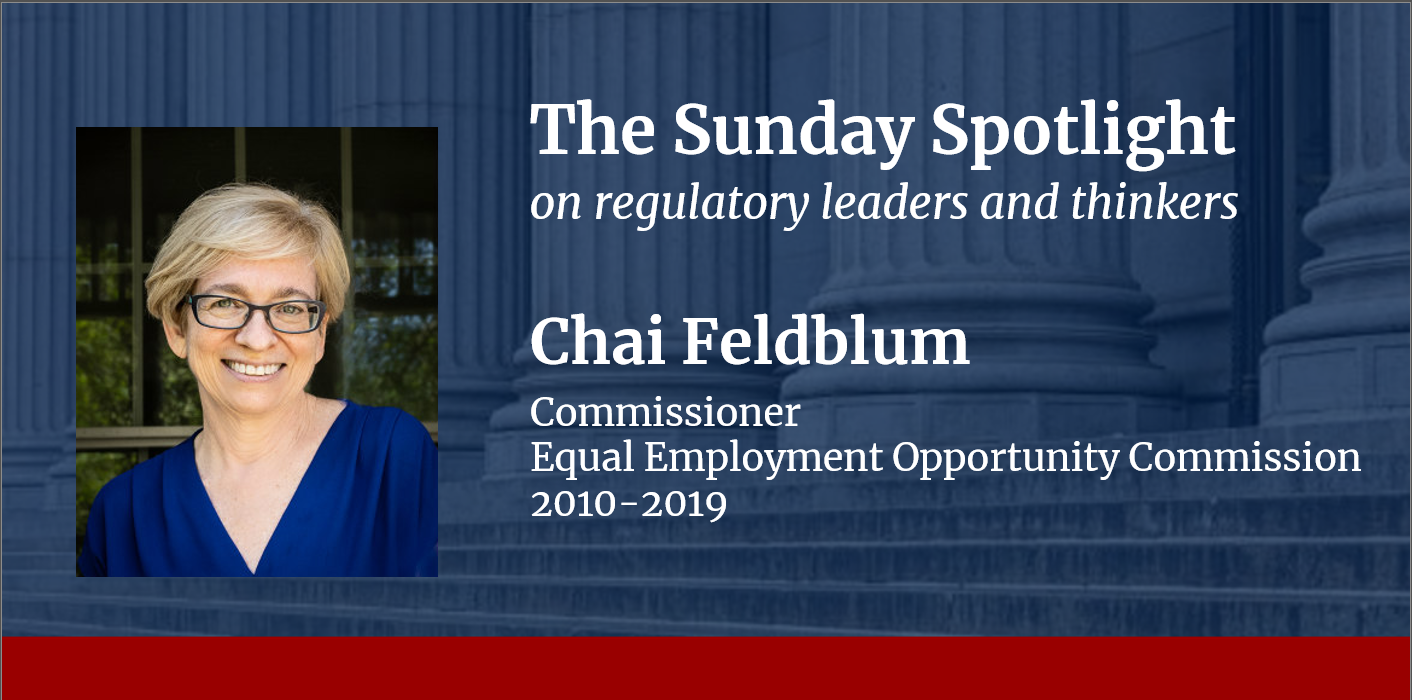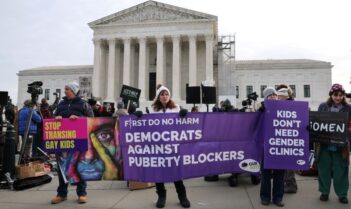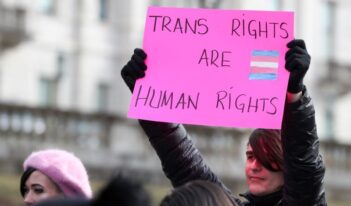
Chai Feldblum discusses the role of administrative agencies in advancing workplace equality and protecting civil rights.
In a conversation with The Regulatory Review, Chai Feldblum, former commissioner of the Equal Employment Opportunity Commission (EEOC), reflects on how federal agencies can protect workplace and civil rights amid shifting legal and political landscapes.
Administrative agencies translate broad statutory mandates into concrete protections for workers. In recent years, debates over agency authority and the scope of administrative power have intensified. Feldblum highlights the need for agencies to adapt to these constraints while preserving their ability to implement antidiscrimination laws effectively.
Drawing on her experience at the EEOC, Feldblum discusses how agency officials and civil rights advocates can build coalitions to strengthen workplace protections and maintain public confidence. She recently co-founded two groups: Pride in Exile, a non-profit supporting equal employment opportunity for LGBTQ+ individuals; and EEO Leaders, a group of former regulatory officials working to promote public understanding of civil rights enforcement.
Feldblum played a critical role in the drafting of the Americans with Disabilities Act of 1990 (ADA) and the ADA Amendments Act of 2008. She formerly served as a professor of law at Georgetown University Law Center and as vice chair of the AbilityOne Commission. Feldblum, who was appointed by President Obama, served as a commissioner of the EEOC for nine years. Today, she consults with organizations on fostering respectful and inclusive workplaces.
The Regulatory Review is pleased to share the following interview with Chai Feldblum.
The Regulatory Review: What do you view as some of the most notable actions or initiatives during your tenure at the EEOC?
Feldblum: There were several notable actions and initiatives at the EEOC during my tenure. For example, the EEOC ruled that discrimination based on sexual orientation and gender identity were forms of sex discrimination, and hence LGBTQ people enjoyed protection under existing employment non-discrimination law. That laid the groundwork for the Supreme Court’s decision in Bostock v. Clayton County, solidifying coverage for LGBTQ people under Title VII. The EEOC also issued guidance that pregnant workers were entitled to accommodations under the Pregnancy Discrimination Act (PDA), contrary to every previous court ruling. This laid the groundwork for the Supreme Court’s decision in Young v. UPS, solidifying such protection. Finally, the EEOC issued regulations implementing section 501 of the Rehabilitation Act of 1973, establishing expectations for federal agencies in hiring and promoting people with disabilities.
There were also several procedural initiatives at the EEOC that may not have been as visible to the public. The most notable was the development of a Strategic Enforcement Plan for 2013-2016, which established agency-wide strategic priorities. At the point that we developed that plan, the agency had not enacted a national enforcement plan for over 18 years. This plan generated many process changes that enhanced the efficiency and impact of the agency’s work. Sometimes the initiatives that do not get the most public exposure are those that change an agency most dramatically.
TRR: Since you left the EEOC, the Supreme Court has decided some important regulatory cases, including Loper Bright Enterprises v. Raimondo, in which the Court overturned its Chevron doctrine requiring judicial deference to agency statutory interpretations. How has the Loper Bright decision changed the work of agencies tasked with protecting civil rights, including the EEOC?
Feldblum: The Loper Bright decision enhanced the power of the courts at the expense of agencies. But it did not nothing to reduce the power of statutes as passed by Congress. If an agency, in its regulations or guidance, interprets a statute in a particular way, and persuasively explains its analysis, that is likely to impact a court’s interpretation of the statute. That means the work of an agency remains quite important, and indeed, the decision incentivizes agencies to develop and present their analyses in a rigorous and persuasive manner.
Ironically, the Loper Bright case also now helps protect employment civil rights. That is because several civil rights agencies, including the EEOC, have ignored or undermined the protections of laws duly enacted by Congress. For example, in May 2025, the EEOC removed from its harassment guidance all references to examples of harassment based on sexual orientation or gender identity. It did so because one district court judge ruled that Title VII does not prohibit harassment on such bases, despite the Supreme Court’s clear ruling in Bostock to the contrary.
While it is unfortunate that the current EEOC leadership took that action, the bottom line is that courts can simply ignore the modified EEOC guidance because it is clearly not a persuasive interpretation of Title VII under Bostock. Under the Loper Bright standard, courts can ignore a number of changes to regulations and guidance that we can expect from the EEOC and other civil rights agencies in the coming few years.
TRR: You wrote that the EEOC “changed the legal landscape” by “reinvigorating” the argument that discrimination on the basis of sexual orientation is a form of sex discrimination, as the Supreme Court ultimately held in Bostock. How might other agencies follow the EEOC’s example to change legal frameworks?
Feldblum: I think the Loper Bright decision presents a clear roadmap for how agencies might change an existing legal framework. The key element for an agency to understand is that it cannot interpret a statute in a manner that is not strongly persuasive. But sometimes, agencies and the courts have previously interpreted a statute in a manner that is neither accurate nor persuasive, and agencies can change that legal landscape by returning to the plain language of the statute and providing a more persuasive interpretation.
For example, for decades, the EEOC and the courts ignored the reality that “discrimination based on sex” logically covers discrimination against an individual because of the sex of the person they are attracted to, or because the person has aligned their sex with their gender identity. The fact that the EEOC and the courts had gotten this wrong for decades did not stop the EEOC from correcting this interpretation starting in 2011. The same situation existed regarding accommodations for pregnant workers under the PDA. I was flabbergasted when I read case after case holding that the PDA did not provide the right to an accommodation for pregnant workers. That conclusion was so contrary to the plain words of the statute that it was easy to construct EEOC guidance that established such protection.
TRR: What did you learn from your time at the EEOC about how an agency should respond when its regulatory goals or efforts, especially those involving equal opportunity or civil rights, attract political attention or debate?
Feldblum: The responsibility of an agency is to implement and enforce the law as Congress wrote it, not as the agency might have wanted it. If that is the north star of the agency, I think it can weather any political attention or debate.
As an advocate, my responsibility was to push for laws and regulations that would help the groups I represented. My role was very different as a Commissioner—my responsibility was to implement employment civil rights statutes as enacted by Congress and to ensure the agency operated in an efficient and appropriate manner. If what the agency did in these areas subsequently generated political attention or debate, that was fine. What was important was that the agency had arrived at its decisions and actions in a manner consistent with its responsibility.
TRR: You have emphasized the importance of aligning law, social norms, and policies in achieving social justice goals. How can the EEOC and other regulatory actors help do so to advance workplace equality?
Feldblum: Social change, including the achievement of workplace equality, never happens in a vacuum—there are always different components in play. Obviously, law is one important component. If the government mandates a form of workplace equality, there is a decent chance that such equality will be achieved. But achieving that goal will also depend on what type of policies and practices employers deploy on the ground to comply with the law. Employers and workers must understand their responsibilities and rights under the law. Finally, to truly achieve workplace equality, ordinary people in the workplace must believe in the legitimacy of that goal.
These components can further one another. Social norms can generate the adoption of voluntary policies, which can then help ensure passage of a law. Passage of a law can result in the adoption of more employer policies, which can then further advance social norms. Agencies should realize that they operate within this integrated system and play an important role in it.
TRR: What are some of the most important functions of EEO Leaders, which you helped launch in 2025? Should other former agency leaders establish such groups?
Feldblum: We organized a group of former high-level EEOC and Office of Federal Contract Compliance (OFCCP) officials to respond to actions by the President, the current EEOC, and other civil rights agencies that have undermined civil rights laws. EEO Leaders monitors executive branch actions that dilute the enforcement of the law or mislead employers and workers about their rights and responsibilities under the law. We respond with clear and accessible documents that lay out the real legal requirements.
Essentially, we are doing the job that any credible civil rights agency should do. Unfortunately, there is a real need for us to actively respond to harmful actions being taken by the current Administration. My sense is that the documents we have produced thus far have been helpful to employers, workers, policy makers, and the media. Former leaders of other agencies may be working together in a similar manner. We may have just been the first to officially organize.
TRR: How has your time working inside the federal government influenced your current work with Pride in Exile involving the rights of LGBTQ+ employees?
Feldblum: All three co-founders of Pride In Exile were connected through service at the EEOC. The initial impetus was to offer a space for EEOC employees who had been members of the agency’s LGBTQ+ affinity group to gather after EEOC leadership forced the dissolution of that and other affinity groups. We soon came to realize, however, that the EEOC was not doing its job to protect federal employees from discrimination on the basis of sexual orientation and gender identity, and so we expanded our mission to disseminate information and provide support to all LGBTQ+ federal employees and their allies. The EEOC was also failing in its duty to protect any LGBTQ+ person who deserved the protection of Title VII. Our current mandate, therefore, is to monitor all actions taken by the EEOC that affect LGBTQ+ people across the nation and to disseminate information to help such individuals vindicate their rights. We cannot provide direct legal support to such individuals, but we can collect their stories, provide them with accurate information, and help develop a sense of community.



